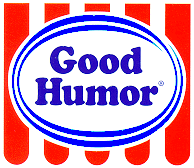Good Humor facts for kids
 |
|
| Product type | Ice cream brand |
|---|---|
| Owner | Good Humor-Breyers (Unilever) |
| Country | Youngstown, Ohio, U.S. |
| Introduced | 1920 |
| Markets | United States |
| Previous owners | Good Humor Corporation of America |
Good Humor is a famous brand of ice cream that started in the early 1920s in Youngstown, Ohio, United States. It was created by Harry Burt and is known for its delicious chocolate-coated ice cream bars on a stick, called the Good Humor bar. These treats were often sold from special ice cream trucks and in stores. Good Humor became a big part of American culture in the 1950s, with as many as 2,000 "sales cars" (ice cream trucks) on the road! Today, it's part of Good Humor-Breyers, which is owned by Unilever.
Contents
The Story of Good Humor
The original Good Humor company began in Youngstown, Ohio, in the early 1920s. By the mid-1930s, its tasty treats were sold across most of the country. In 1961, a big company called Thomas J. Lipton (which is part of the even larger international company Unilever) bought Good Humor.
Over time, the company faced challenges. Many of the original customers, the "baby boomers" (people born after World War II), grew older. Also, the costs of running the trucks, like gas and insurance, went up. Because of these reasons, Good Humor stopped operating its own fleet of ice cream trucks in 1978. However, they continued to sell their products in grocery stores and through other independent sellers.
By 1984, Good Humor was doing well again. In the late 1980s and early 1990s, Unilever helped Good Humor grow even more by buying other popular ice cream brands like Popsicle and Klondike. They also bought the Breyers Ice Cream Company. All these brands came together to form Good Humor-Breyers, which became a huge producer of ice cream and frozen treats. Good Humor is now part of Unilever's international Heartbrand family of ice cream brands.
How it Started: The Burt Family (1920s)
In 1919, a store owner named Christian Nelson invented a way to cover an ice cream bar with chocolate, creating the Eskimo Pie. When Harry Burt, who owned an ice cream shop in Youngstown, Ohio, heard about this, he tried to make his own version.
The story goes that Harry Burt's 23-year-old daughter, Ruth, found the chocolate-covered ice cream too messy to eat. Then, his son, Harry Jr., had a brilliant idea: why not put a wooden stick in it to make it easier to hold? They tried it out, and it worked perfectly! The stick froze firmly into the ice cream.
In 1920, Harry Burt started selling his "Good Humor Ice Cream Suckers" from twelve street vending trucks in Youngstown. These trucks had small freezers and bells to announce their arrival. The first bells he used were from his son's old bobsled! By 1925, Harry Burt Jr. even opened a Good Humor business in Miami, Florida.
Harry Burt applied for patents for his invention in 1922. It took until 1923 for them to be approved because the patent office thought they were too similar to Eskimo Pies. Harry Burt Jr. had to travel to Washington, D.C., with samples to show how Good Humors were different. The patents they received were for the special equipment and process to make frozen treats on a stick.
Around the same time, another person named Frank Epperson started selling frozen ice on a stick and created the Popsicle Corporation. Good Humor and Popsicle had a disagreement about their patents, but they settled it in 1925. They agreed that Popsicle could make frozen treats from ice and sherbet, while Good Humor could make them from ice cream and frozen custard.
Harry Burt passed away in 1926. A couple of years later, his wife sold her share of the company to a group of businessmen who renamed it the Good Humor Corporation of America. They started selling franchises, allowing others to open Good Humor businesses in different areas.
Growth and Popularity (1930–1961)
A businessman named Michael J. Meehan became a major owner of the Good Humor Corporation of America in 1929. The company did very well, even during the Great Depression, because its ice cream was an affordable treat for many people.
Good Humor used not only trucks but also push carts, bicycles, and even shoulder boxes to sell their products. In most places, they sold ice cream for about six months of the year, from April to September. Jobs were hard to find back then, so Good Humor had many employees, even though the work involved long hours. Women were not hired as vendors until 1967.
Good Humor vendors had to follow strict rules. They even attended classes to learn how to sell the ice cream and how to greet customers. For example, they had to say "Ice Cream Good Humor" instead of "Good Humor Ice Cream." Vendors were paid based on how much they sold, and many earned good money for the time.
To make their products even more popular, Good Humor used a "lucky stick" promotion. If you found "lucky stick" stamped on your ice cream stick, you won a free Good Humor! This promotion was later stopped. The company also got a lot of attention by parking their trucks outside movie studios. Good Humor appeared in over 200 movies, and in 1950, a movie called The Good Humor Man was even made about them.
After World War II, Good Humor expanded into the growing suburbs, where many families with young children lived. About 55% of Good Humor's customers were 12 years old or younger. By 1956, the company had grown to 2,000 trucks! By 1960, Good Humor offered 85 different treats, including sundaes, single-serve cups, and many different kinds of chocolate-coated bars.
Good Humor Today: Part of Unilever (1961–Present)
In 1961, the Meehan family sold Good Humor of America to Thomas J. Lipton, which is a part of Unilever. Unilever also bought other Good Humor businesses. After this, Good Humor started selling its products in supermarkets, creating a new way for people to buy their ice cream.
Over time, the company faced more challenges. Many of their older trucks needed to be replaced. Also, as the "baby boomers" grew up, fewer people bought ice cream from the trucks in some areas. New competitors, like Mister Softee with their soft ice cream trucks, also appeared. The cost of insurance went up because ice cream vendors were sometimes held responsible for accidents involving children crossing the street to get to the truck.
Good Humor tried to adapt by replacing some older trucks with larger vans, similar to those used by Mister Softee. They also worked with safety organizations to add "stop" swing arms to their trucks, like those on school buses, to help prevent accidents.
However, Good Humor continued to face difficulties with its truck operations. In 1978, after losing money for ten years, Good Humor decided to stop operating its own street vending trucks. They sold their trucks, and many former Good Humor vendors became independent business owners, buying products from Good Humor to sell.
With the trucks sold, Good Humor focused on selling its products in grocery stores. This helped the company become profitable again by 1984. Unilever, which is one of the world's largest ice cream companies, decided to expand its presence in the U.S. by buying more brands. In 1989, Unilever bought Gold Bond Ice Cream, which owned Popsicle. In 1993, they bought Isaly Klondike, another brand known for chocolate-coated ice cream bars. Also in 1993, Unilever acquired the Breyers Ice Cream Company. All these brands were combined to form the new company called Good Humor-Breyers.
Since 2000, Good Humor has been one of many Unilever ice cream brands that use the international Heartbrand logo. In 2020, Good Humor worked with music producer RZA to create a new, positive jingle for ice cream trucks to play. This was done to replace an older song, "Turkey in the Straw", which had been linked to racist lyrics in the past. Even though Good Humor doesn't operate its own trucks anymore, they wanted to encourage drivers to play a more welcoming tune.
Good Humor Products
Originally, a "Good Humor" was a three-ounce vanilla ice cream bar on a stick, covered in chocolate. By 1960, the company offered a huge variety of 85 different flavors and combinations!
Other popular "Good Humors" included chocolate-covered chocolate (sometimes called "chocolate malt") and chocolate-covered strawberry. They also had bars coated in toasted almond, coconut, chocolate cake, strawberry shortcake, and chocolate éclair. Good Humor even had weekly specials with unique flavors, like a red, white, and blue Good Humor for the Fourth of July. Some experimental flavors, like Oregon prune and California fig Good Humors, didn't become as popular. They even tried making tomato sherbet!
Fun Facts and Stories
The history of Good Humor is full of interesting stories. For example, there's a tale about a Good Humor vendor who helped rush a baby to the hospital. Another story tells of the company helping to uncover a counterfeit money operation on Long Island.
During World War II, a Good Humor truck was once assigned to follow an army during training exercises. The commander was confused because the opposing side seemed to know his army's location too easily. He then realized that the enemy spotters were using the bright white Good Humor truck as a guide! Instead of taking away his troops' ice cream, the commander ordered the truck to be painted army green that night.
After the war, a Good Humor vendor once accepted a new magazine from a child who was a nickel short for an ice cream. The next day, the street was filled with children eager to trade their magazines for Good Humors!
See also
sv:Heartbrand#Övriga företag







